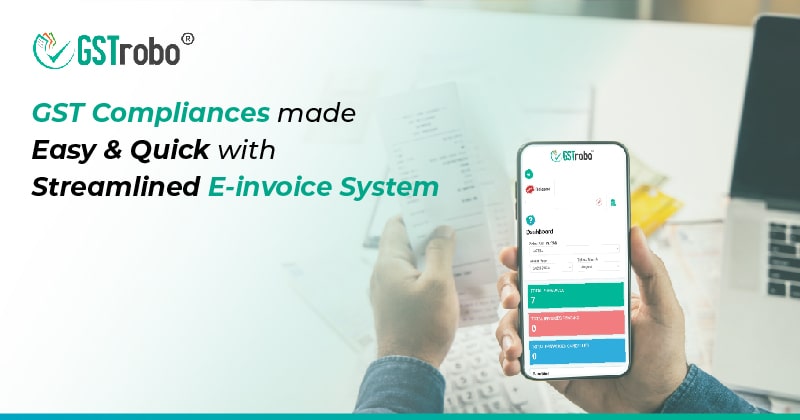GST Compliances Made Easy & Quick with Streamlined E-invoice System
E-invoice can be called one such government mandate that changed how India does business since 2020. Since its introduction, the visionary reform has brought about substantial and systematic changes by digitizing the transaction processes and carving a path for machine-readability and interoperability amongst business and compliance ecosystems.

Aside from that, the principal feature of e-invoicing in the Indian landscape has been how it has streamlined the way GST compliance problems have been addressed. Invoice standardization has improved and enhanced account receivables management, regulated and trackable e-way billing system, regiment e-invoice reporting, more straightforward & quick data reconciliations, and on-time GST return filing.
Let’s see how the e-invoicing system makes the adoption of GST compliance easier and provides businesses with ease of compliance of online registration, returns, and refund procedures.
Aids Tracking and Transparency
Before 2020, businesses and enterprises were mainly following traditional or paper-based e-invoicing systems, which was not just difficult to keep track of, but it also caused a tremendous amount of ambiguity amongst the various departments. There was the occurrence of regular mistakes and delays in business operations, hence causing further fallacies in GST return fillings and payment of taxes.
The electronic invoicing process has shifted businesses from offline to online, with e-invoices being generated using e-invoicing software solutions or on the government’s official portal.
Now, stakeholders can easily access all the necessary information of e-invoices generated wrt. the date of issue, time of issue, GSTIN of the purchaser and supplier, IGST Value, CGST Value and SGST Value, GST Rate, assessable value, buyer and supplier’s address, state, details of preceding debit and credit notes, IRN and HSN.
These details help all departments quickly track the e-invoices generated and stay on time to generate necessary GST return filings, tax payments, and claim timely ITCs. It also makes it convenient while GST audits or when generating financial reports, as everyone can access past invoices, payment records, and customer details.
Keeping Pace with Global Trends & Norms
For a country to grow and prosper, staying relevant to the changing and accelerating global phenomena is imperative. World has already switched to online solutions and advanced technology when it comes to GST and tax. Tax technology and digital transformation play a vital role in optimizing business processes. Reducing manual intervention and minimizing errors can only be achieved with advanced software solutions.
For an economy to grow, international trade and cross-border transactions must increase, which requires a steady adaption to different countries’ invoicing regulations, tax laws, and currency formats.
In today’s fast-paced business landscape, compliance with tax regulations and financial reporting standards is a top priority for every organization. Managing invoices efficiently is crucial to staying compliant and avoiding costly penalties. Businesses are turning to modern invoicing systems to streamline this process and simplify compliance.
Keeping Compliant to Accurate Tax Calculation
The biggest challenge for an organization while staying compliant with GST regulations and incorporating it aptly in their business operations is correctly calculating the GST amount to be paid. The E-invoicing system has automated the whole process of tax calculations and reduced the chances of errors to almost Nil, ensuring accurate tax reporting. This automation saves time and minimizes the chances of financial discrepancies, improving the company’s reputation and credibility.
Integrated Payment Solutions
With e-invoicing software, the process of payments of invoices by clients has become quick and convenient. With just a click of a button, one can instantly make payments using options like credit cards, debit cards, and bank transfers. This enhances customer convenience and accelerates the payment process, positively impacting cash flow and financial compliance.
Simplified Reporting & Real-Time Data Analytics
For easy regulatory compliance, an organization requires standardized financial reports. An automated process that generates accurate reports in a few seconds is a game-changer. An e-invoicing software does that and makes tax reports, profit and loss statements, and balance sheets in single-click automatically.
Invoicing system offers real-time monitoring of financial transactions, allowing businesses to keep track of their revenue and expenses promptly. This real-time visibility enables quick decision-making and ensures that any discrepancies or anomalies are detected early, reducing the risk of potential compliance issues.
Sheltering Data & Privacy
For an organization to secure its sensitive data is a must to ensure GST compliance requirements. To mitigate any compliance-related risks and to ensure the confidentiality and integrity of sensitive financial information, the e-invoicing system comes in handy. Organizations have the option to give access to data only to the people they want and inculcate confidentiality and integrity of sensitive financial information.
Conclusion
GST and E-invoicing process goes hand-in-hand, revolutionizing the country’s digital transformation in how people pay taxes and follow tax regulations. One complements the other in keeping business operations records and making processes simple. These two digital mandates have seamlessly brought into its umbrella other processes like reconciliations, tax return filing, and input tax credit claims.
This has also enhanced tax solutions via data analytics and artificial intelligence (AI) by detecting revenue leakages. It is only time that Indian enterprises, businesses, organizations, and MSME taxpayers make this mandate a way of doing business and reap its benefits. Keeping pace with global norms and trends through an invoicing system is an essential step for businesses aiming to succeed in the increasingly interconnected and dynamic global market.
In today’s business environment, managing compliance is not just an option; it’s a necessity. As organizations look to streamline their operations and stay ahead of the competition, integrating an invoicing system is undoubtedly a strategic move toward making compliance easy and quick.
